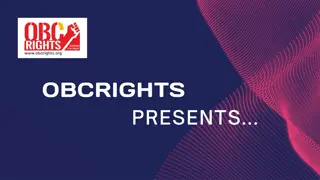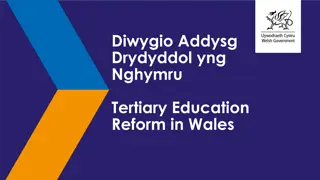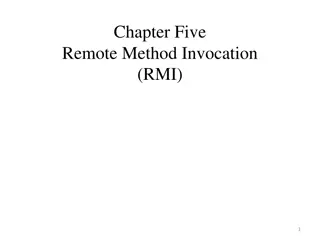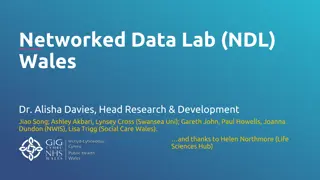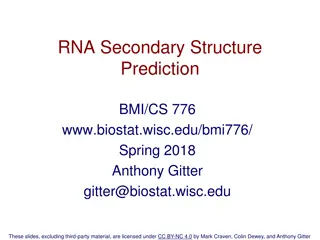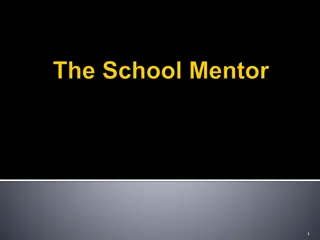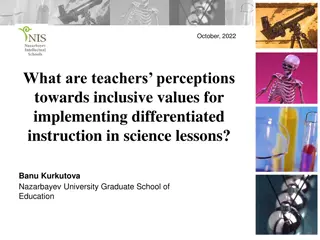Exploring Distributed Leadership Perspectives Held by Secondary Head Teachers in South Wales
This research delves into the perspectives on distributed leadership (DL) held by secondary head teachers in South Wales. The study aims to understand how head teachers define and implement distributed leadership in their schools, exploring concepts such as trust, accountability, and the role of external bodies. Methods include qualitative interviews with eight head teachers from various secondary schools in South Wales, each anonymized for analysis purposes.
Download Presentation

Please find below an Image/Link to download the presentation.
The content on the website is provided AS IS for your information and personal use only. It may not be sold, licensed, or shared on other websites without obtaining consent from the author. Download presentation by click this link. If you encounter any issues during the download, it is possible that the publisher has removed the file from their server.
E N D
Presentation Transcript
Give and Take: An Exploration of Give and Take: An Exploration of Perspectives on Distributed Perspectives on Distributed Leadership Held by Secondary Leadership Held by Secondary Head Teachers in South Wales Head Teachers in South Wales Matt Hutt University of South Wales, Newport, UK BERA Conference 2017
Distributed Leadership: Why conduct further Distributed Leadership: Why conduct further research? research? DL often interpreted in different ways ( elasticity of the term Hairon and Goh 2015) Nevertheless, DL invariably talked about in positive terms by practitioners (Hall et al. 2013) DL reaching hegemonic status (Gronn 2015) Support for DL inscribed in HMI (Estyn) thematic reviews (e.g. Estyn 2015) matthew.hutt@southwales.ac.uk
Distributed Leadership: what did I want to Distributed Leadership: what did I want to explore in more detail? explore in more detail? Head teachers definitions of distributed leadership How they actively distribute leadership in school to teams etc How they reconcile ideas of trust and accountability with DL The role they perceive that external bodies and organisations have in supporting or inhibiting distributed leadership matthew.hutt@southwales.ac.uk
Methods Methods Qualitative approach, using semi-structured interviews Interpretivist emphasis on perceptions held by participants Grounded Theory approach to data analysis and coding of interviews Purposeful sampling, using contacts in the local consortia Interviews took place from Oct 15 to May 16 Participants were invited to comment on findings and conclusions matthew.hutt@southwales.ac.uk
Participants Participants Eight head teachers in a variety of secondary schools in South Wales (including a Welsh medium, a 3-16 through school and a range of semi-urban schools) Schools were assigned alternative names to retain the possibility in the future of analyzing them as distinct narrative units (Rowan Ridge, Cedar Way, Hedge Hill, Elm Grove, Beech Wood, Sycamore Park, Oak View and Fir Valley) matthew.hutt@southwales.ac.uk
Findings (1) Findings (1) Participants were universally positive about the concept of DL First of all, any head who perceives they are the only voice of leadership in a school is asking for trouble. (HT OH). It's really trite to say that I can't lead an organization of this size. In super heads, I don't believe in [them]. It has to be a team approach and it has to be a big team approach. (HT EG) But I think it's very easy to go on about leadership. 'We need strong heads in our schools , you know? Yeah, okay, fair enough. What you actually need is strong teams in schools. (HT RR) My perception of headship has completely changed now. I used to think it was all about what I did [Now] I don't think it is. I think it's more about how effective you are [at] enabling other people to do things. (HT CW) matthew.hutt@southwales.ac.uk
Findings (2) Their definitions were generally quite similar, in terms of positioning DL as a dispersal of leadership responsibility. carmel.conn@southwales.ac.uk
Findings: different perspectives Findings: different perspectives Key elements: A thoroughgoing positive, philosophical vision of distributed leadership was explored by two participants Aspects of school which are seen as supportive/ conducive to DL tended to be emphasized by the remaining six participants Challenges identified by all participants when attempting to enact DL matthew.hutt@southwales.ac.uk
Findings: positive vision (1) Findings: positive vision (1) Pursued in greatest detail by two of the eight participants: Derived from previous experiences When I think back to my career as a middle leader, the senior leaders that I felt were the most effective and got the most out of me and the other middle leaders in my institution were ones who were doing this [distributed leadership]. Clearly they were doing it. When I think back to my most influential head in my time when I was a middle leader, this was absolutely the way that she used to work. And that brought me on. (HT CW) matthew.hutt@southwales.ac.uk
Findings: positive vision (2) Findings: positive vision (2) Pursued in greatest detail by two of the eight participants: Theme of giving people more autonomy over decision making There's a good quote from Napoleon actually, which is that when I give a general a task to do, I expect him to do it. And I don't expect to tell him how to do it , or whatever, something like that. And I think that is part of distributed leadership to me, when distributed leadership is effective, you don't say to somebody I want you to do this . You say, I want this in our school . (HT RR) matthew.hutt@southwales.ac.uk
Findings: positive vision (3) Findings: positive vision (3) Pursued in greatest detail by two of the eight participants: Theme of not interfering , not breathing down people s necks Yeah, you've got to convince them [colleagues within school] that you do trust them. Either by saying that fairly regularly or at least leaving them alone to get on with it and not make them [think] that you're watching them all the time. (HT CW) matthew.hutt@southwales.ac.uk
Findings: positive vision (4 and 5) Findings: positive vision (4 and 5) Pursued in greatest detail by two of the eight participants: Theme of creating elaborate routines to engage people in decision making Promoting an ethos of teamwork I don't think that the key question three should be called leadership . I think it should be called teamwork . (HT RR) matthew.hutt@southwales.ac.uk
Findings: aspects of school culture/ practice that Findings: aspects of school culture/ practice that contribute to DL contribute to DL Key aspects identified by participants: Teamwork Professional development/ training (general) Professional development (leadership capabilities) Ethos/ culture of clarity and transparency It's linked I think as well to communication, how clear you are at different levels, (HT SP). So I keep them to account by making sure [they] have a very, very clear framework of what they're responsible for. (HT BW) matthew.hutt@southwales.ac.uk
Findings: challenges perceived by head Findings: challenges perceived by head teachers in relation to DL (1) teachers in relation to DL (1) A perceived need to re-stating formal hierarchy: You have to sometimes win some really, nasty, vicious battles in order to develop culture. I mean, you have to lead from the front, if you're going to go tell them. (HT BW) I think we're still in that situation within the school. I think there's still that confidence thing, that there's still the desire for me to rubber stamp something, and I'm conscious that that comes from me as much as it does from them. [My emphasis] (HT SP) In a school situation, you still have to be so confident that you ve got to be a big presence in the school. You've got to be the person [that] people know [is] making decisions at the end of the day. And they can discuss these with you, but you know you are nevertheless, the boss. So in a distributed model, it is still actually crystal clear, that hierarchy we talked about, still has to be there. (HT RR) matthew.hutt@southwales.ac.uk
Findings: challenges perceived by head Findings: challenges perceived by head teachers in relation to DL (2) teachers in relation to DL (2) Emphasized need for consistency You still need to be careful, because as I said, if you have a larger team of people doing things, you've got to be careful that consistency isn't lost, right? And it can be with little things like line management, for example. If you have lots of people doing line management, it can be lost, if people don't have the time, or they don't feel as if they do things in the same way as other people or if they don't feel as though they need to. (HT BW) [In some schools] only a few people do it [evaluate teaching and learning]. But I'm not sure, I'm not sure about that because, you need to see excellence everywhere. And you need to understand underperformance everywhere. Because that one person, or those few people find it very difficult to lead the developments, lead the change. (HT BW) They [Estyn and EAS] want both. They want distributed leadership, but they want accountability and consistency at the same time. You can get caught on both sides. (HT BW) matthew.hutt@southwales.ac.uk
Findings: challenges perceived by head Findings: challenges perceived by head teachers in relation to DL (3) teachers in relation to DL (3) Paradox of micro-management How do you ensure that that element of distributed leadership is consistently done? You have to micromanage it a bit. (HT BW) You've got to have some element of quality assurance, and that's where the micro-management comes in. (HT BW) matthew.hutt@southwales.ac.uk
Conclusions: key questions Conclusions: key questions 1) strongly in interviews about distributed leadership? 2) Why should the concepts of clarity and transparency also be strongly emphasized by the participants when discussing distributed leadership?, and 3) Why should participants invoke references to detailed micro- management whilst simultaneously exploring their commitment to distributed leadership? 4) To what extent are accountability measures circumscribing DL in practice? 5) Are there sufficient levels of trust circulating in the system? Why should the concept of professional development feature so matthew.hutt@southwales.ac.uk
Matt Hutt Senior Lecturer Education, Leadership and Management USW matthew.hutt@southwales.ac.uk References: Estyn (2015) Guidance on the inspection of secondary schools. Cardiff: Estyn Estyn (2015) Best practice in leadership development in schools. Cardiff: Estyn Gronn, P. (2015) The view from inside leadership configurations , Human Relations, 68(4), pp. 545-560. Hairon, S. and Goh, J. (2015) Pursuing the elusive construct of distributed leadership: Is the search over?, Educational Management, Administration and Leadership, 43(5), pp. 693-718. Hall, D., Gunter, H and Bragg, J. (2013) The strange case of the emergence of distributed leadership in schools in England , Educational Review, 65(4), pp. 467-487. matthew.hutt@southwales.ac.uk



